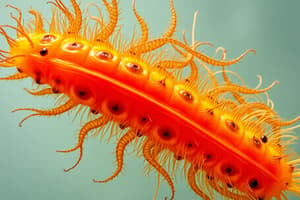Podcast
Questions and Answers
What is the estimated time period when life originated on Earth?
What is the estimated time period when life originated on Earth?
- 4.5 billion years ago
- 1.5 billion years ago
- 2.0 billion years ago
- 3.6 billion years ago (correct)
Which type of organisms were the first believed to have existed on Earth?
Which type of organisms were the first believed to have existed on Earth?
- Plants
- Unicellular organisms (correct)
- Fungi
- Multicellular organisms
How many species are currently estimated to be living on Earth?
How many species are currently estimated to be living on Earth?
- 7.5 million species
- 10 million species
- 8.7 million species (correct)
- 5 million species
What is the primary benefit of grouping organisms?
What is the primary benefit of grouping organisms?
Which type of organism is not included in the 15 species listed?
Which type of organism is not included in the 15 species listed?
What is the highest taxonomic level for the Coconut tree?
What is the highest taxonomic level for the Coconut tree?
Which of the following categories is not present in the hierarchy of categories for Modern Humans?
Which of the following categories is not present in the hierarchy of categories for Modern Humans?
Which Domain does the Coconut tree belong to?
Which Domain does the Coconut tree belong to?
Which classification system was introduced by Carl Woese?
Which classification system was introduced by Carl Woese?
What is the correct order of taxonomic levels for Modern Humans from Domain to Species?
What is the correct order of taxonomic levels for Modern Humans from Domain to Species?
Which domain of life consists of organisms that are not sensitive to most antibiotics?
Which domain of life consists of organisms that are not sensitive to most antibiotics?
What type of organisms belong to the Domain Bacteria?
What type of organisms belong to the Domain Bacteria?
Which of the following is NOT a characteristic of organisms in the Domain Archaea?
Which of the following is NOT a characteristic of organisms in the Domain Archaea?
Which group of organisms is the most abundant and can be found everywhere in the environment?
Which group of organisms is the most abundant and can be found everywhere in the environment?
Which of the following is an example of an organism that falls under the Domain Archaea?
Which of the following is an example of an organism that falls under the Domain Archaea?
What is the primary purpose of classifying organisms?
What is the primary purpose of classifying organisms?
Which classification method considers evolutionary relationships among organisms?
Which classification method considers evolutionary relationships among organisms?
Who introduced the first scientific classification of organisms?
Who introduced the first scientific classification of organisms?
Which is NOT a feature of natural classification?
Which is NOT a feature of natural classification?
In the artificial classification of plants, which of the following is NOT considered?
In the artificial classification of plants, which of the following is NOT considered?
What is an example of a taxonomic level for modern humans?
What is an example of a taxonomic level for modern humans?
Which statement about artificial classification is true?
Which statement about artificial classification is true?
Which of the following is a domain in the three domain system proposed by Carl Woese?
Which of the following is a domain in the three domain system proposed by Carl Woese?
What distinguishes natural classification from artificial classification?
What distinguishes natural classification from artificial classification?
What is NOT a benefit of classifying organisms?
What is NOT a benefit of classifying organisms?
Study Notes
Origin and Diversity of Life
- Life on Earth is estimated to have originated approximately 3.6 billion years ago as unicellular organisms.
- Evolution led to the emergence of complex multicellular organisms.
- Approximately 8.7 million species currently inhabit Earth, showcasing vast biodiversity.
Importance of Classification
- Classification simplifies the study of organisms.
- It allows identification of specific characteristics of organisms.
- Studying selected organisms provides insights into the entire biosphere.
- Classification helps reveal relationships between different organisms.
- Identifying organisms with economic significance benefits humans.
Historical Methods of Classification
- Aristotle introduced the first scientific classification in the 4th century B.C.
- Carolus Linnaeus developed a more successful classification in the 18th century A.D.
- Two primary methods of classification exist: Artificial and Natural.
Artificial Classification
- Based on observable features, such as presence/absence of limbs and habitats.
- Does not reflect evolutionary relationships.
- Examples:
- Plants: ornamental, herbal, poisonous.
- Animals: those with wings vs. those without.
- Weakness: Groups unrelated organisms (e.g., birds and insects categorized together).
Natural Classification
- Reflects evolutionary relationships among organisms.
- Considers various features: morphological, physiological, cytological, and molecular.
- Explains relationships within species and among different organisms.
- Organisms grouped into taxonomic levels in a hierarchical structure.
Taxonomic Hierarchy Example: Modern Humans (Homo sapiens)
- Domain: Eukarya
- Kingdom: Animalia
- Phylum: Chordata
- Class: Mammalia
- Order: Primates
- Family: Hominidae
- Genus: Homo
- Species: Homo sapiens
Three Domain System
- Proposed by Carl Woese in 1969 as an appropriate classification system.
- Includes three domains:
- Domain Bacteria
- Domain Archaea
- Domain Eukarya
Domain Archaea
- Composed of prokaryotic organisms without organized nuclei.
- Thrive in extreme environments (e.g., volcanic regions, hot springs).
- Resistant to most antibiotics.
- Examples include methanogens and halophiles.
Domain Bacteria
- Also consists of prokaryotic organisms.
- Sensitive to antibiotics and can be pathogenic.
- Ubiquitous in the environment; the most abundant group of organisms.
- Includes bacteria and cyanobacteria.
Domain Eukarya
- Eukaryotic organisms with organized nuclei.
- Encompasses a wide range of life forms, including plants, animals, fungi, and protists.
Studying That Suits You
Use AI to generate personalized quizzes and flashcards to suit your learning preferences.
Description
Explore the classification of organisms and the diversity of life on Earth through this quiz. Learn how unicellular organisms evolved into complex multicellular forms over billions of years. Test your knowledge on the key concepts of biological classification and the staggering number of species that exist today.




